


xxxxxThe Zulu leader Shaka,
having united the Zulu clans and built a powerful army, took command
of his people in 1817. From the Zulu homeland in present-
KING SHAKA, FOUNDER OF THE ZULU
EMPIRE c1787 -
(G3b, G3c, G4)
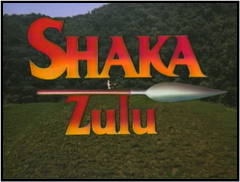
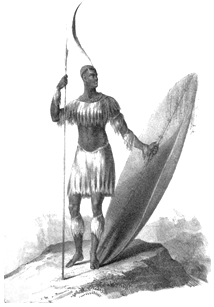 xxxxxKing Shaka, the charismatic but brutal chief of the
Zulus (sometimes Chaka or Tshaka), rose to power as a military
commander in the army of Dingiswayo, paramount chief of the Mtetwa.
In 1816, after six years of distinguished service, he was sent to
subjugate the Zulu, a group of clans of the Nguni people centred
around the White Umfolozi River (in today’s province of Natal). A
Zulu by birth, he carried out his task with ruthless efficiency.
Then, having totally subdued his people by a reign of terror, he set
about reorganising the Zulu army. He rearmed it with an improved assegai -
xxxxxKing Shaka, the charismatic but brutal chief of the
Zulus (sometimes Chaka or Tshaka), rose to power as a military
commander in the army of Dingiswayo, paramount chief of the Mtetwa.
In 1816, after six years of distinguished service, he was sent to
subjugate the Zulu, a group of clans of the Nguni people centred
around the White Umfolozi River (in today’s province of Natal). A
Zulu by birth, he carried out his task with ruthless efficiency.
Then, having totally subdued his people by a reign of terror, he set
about reorganising the Zulu army. He rearmed it with an improved assegai -
xxxxxWith this highly efficient
fighting machine, the like of which had never been seen amongst the
tribal kingdoms of southern Africa, he quickly subdued all the local
clans and increased his army fourfold. Thus in 1817,
when his overlord Dingiswayo was killed at the hands of a rival
clan, the Ndwandwe, he was free to take over command of his people
and extend their territory further. He first attacked and defeated
the Qwabe, a sizeable threat to his dominance, and then turned his
attention on the more powerful Ndwandwe under their leader Zwide.
Employing his new tactics, he defeated them at Gqokli Hill in 1818,
and then routed them at the Mhlatuza River the following year. They,
like many of his opponents, were forced to flee from the region. Now
the undisputed power in south-
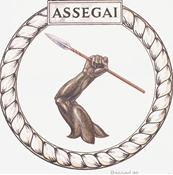 xxxxxSuch was the ruthlessness and cruelty shown by this
warrior king during his campaigns of conquests that, as we have
seen, he set off a huge wave of tribal migrations -
xxxxxSuch was the ruthlessness and cruelty shown by this
warrior king during his campaigns of conquests that, as we have
seen, he set off a huge wave of tribal migrations -
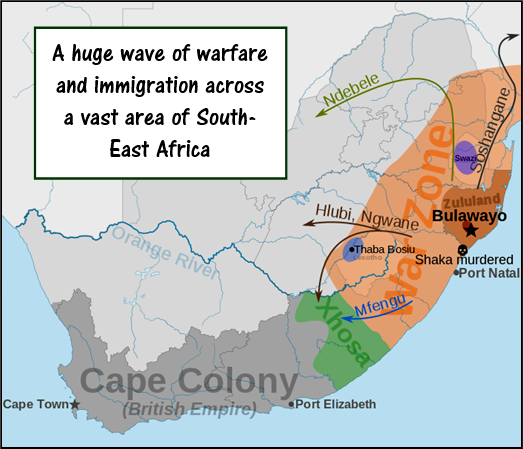 xxxxxThe Mfecane, or Difaqane
as it is called by some, caused havoc and carnage over the next ten
years or so, and brought about far-
xxxxxThe Mfecane, or Difaqane
as it is called by some, caused havoc and carnage over the next ten
years or so, and brought about far-
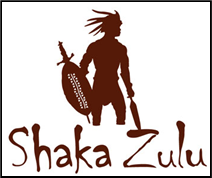 xxxxxAs for the Zulus, their unified nation and formidable
army -
xxxxxAs for the Zulus, their unified nation and formidable
army -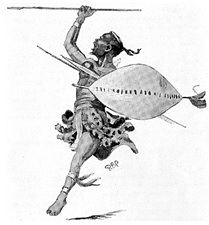 Trek
-
Trek
-
xxxxxIncidentally,
a measure of Shaka’s cruelty can be seen in 1827. In that year his
mother Nandi died and, stricken with grief, he launched a cruel
campaign of violence against his own people. Some 7,000 were massacred -
xxxxx…… In about 1824 Shaka made contact with a number of Europeans who had settled at Port Natal (modern Durban). Intrigued by their way of life, he allowed them to stay, and two of their number, having mixed freely with the Zulus, left the only written account of the early history of the Nguni people. ……
xxxxx……
The South African writer Thomas Mokopu
Mofolo (1877-
G3c-
Acknowledgements
Shaka: licensed
under Creative Commons – www.thefullwiki.org/Shaka_Zulu. Drawing
of 1824, attributed to a 19th century artist, Lt. James King (a
Port Natal merchant), and contained in Travels
and Adventures in Eastern Africa by the
English adventurer Nathaniel Isaacs (1800-


